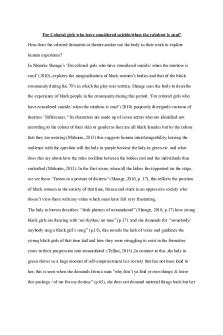Discussion Post: The atomic café PDF

| Title | Discussion Post: The atomic café |
|---|---|
| Course | SFS Proseminar History and popular culture |
| Institution | Georgetown University |
| Pages | 1 |
| File Size | 63.9 KB |
| File Type | |
| Total Downloads | 96 |
| Total Views | 141 |
Summary
How did the atom bomb shape American culture and society in the historical period covered by the film? How did ongoing nuclear weapons testing impact people who lived outside the United States?...
Description
How did the atom bomb shape American culture and society in the historical period covered by the film? How did ongoing nuclear weapons testing impact people who lived outside the United States? I personally have always wondered why a large portion of Americans were so insensitive towards their countries atomic bombings as well as their irrational xenophobia, and I believe this movie helped me better understand where this fear and blind trust they have in their government’s decisions stem from. Just like we studied the Holocaust and the propaganda techniques that the Nazis used in order to pursuade the Germans to believe that Jews and other races are subhumans, the United States used the same propaganda techniques to attenuate the impact of their military decisions and shape the American culture and society in the 1940s and 1950s. This is clearly depicted in the movie “The atomic cafe” which portrays the events taking place post World War 2 and during the Cold war. In fact, it explains the arms race between the Soviet Union and America as both countries increased the size and quality of military resources to gain political superiority over one another. This was reinforced by the new technological advancement of both nations as scientists and physicists raced to invent the most destructive weapon in human history: the atomic bomb. The movie starts with the nuclear testing at Bikini Atoll after the end of WW2 as these occupied lands were used as testing grounds for atomic bombs under the sea, in the air and on land. The speeches given by military officials to convince the natives to evacuate are, in my humble opinion, absolutely ridiculous because, as we can see today, the effects of gamma radiation are still present in the ecosystems of the impacted areas. Simultaneously, the US government was using propaganda techniques to spread fear amongst Americans from Stalin and his communist regime, portraying capitalism as the best, most beneficial regime of all. This fear from the Soviet Union was reinforced in 1949 when Russia conducted its first nuclear test. Thus, pushing Americans to develop the H-Bomb, one thousand times more powerful than the Hiroshima bomb at the end of World War II. Although scientists and some government officials argued against it, US officials ultimately reasoned that it would be imprudent for them not to develop any weapon that the Soviet Union might possess.This fear of nuclear warfare also penetrated the American society in the 1950s when both the US and Soviet Union were stockpiling nuclear weapons. So in order to comfort their citizens, the government used virtue words in the media (radio and TV) and the pathos of American patriots to justify their preparations for war with Russia claiming that they are fighting for national security. Even artists joined the movement by creating songs which were playing in the background of the movie with lyrics undermining the power of atomic bombs. Add to that, military air force short films were created claiming that atomic bombs are not that dangerous and that radiation is the least important side effect citizens should worry about. Furthermore, the word “atomic” became a popular slogan in advertisements for American citizens for cocktails, cabs and other products. This is a euphemism for the impacts of the atomic bomb. They even created animated cartoons diagnosing fear of the “mushroom cloud” as an illness that should be treated and stating that the sight of the bombing is one of the “most beautiful things”. All these examples contributed to shaping the American society’s culture of the time period and its effects still show today in their society as many of the citizens blindly trust their government and never second guess their decisions....
Similar Free PDFs

Discussion Post: The atomic café
- 1 Pages

Discussion Post
- 2 Pages

Discussion Post
- 1 Pages

Week 3 - discussion post
- 1 Pages

Black Panther Discussion Post
- 1 Pages

NEUR3000 Discussion post 7
- 2 Pages

Discussion Post Module 3
- 2 Pages

Module 9 - Discussion Post
- 2 Pages

Example-Discussion Post
- 3 Pages

discussion post dis
- 2 Pages

DQ 1 - Discussion post
- 1 Pages

Week 1 Discussion Post
- 1 Pages

BIO 202 Discussion Post
- 11 Pages
Popular Institutions
- Tinajero National High School - Annex
- Politeknik Caltex Riau
- Yokohama City University
- SGT University
- University of Al-Qadisiyah
- Divine Word College of Vigan
- Techniek College Rotterdam
- Universidade de Santiago
- Universiti Teknologi MARA Cawangan Johor Kampus Pasir Gudang
- Poltekkes Kemenkes Yogyakarta
- Baguio City National High School
- Colegio san marcos
- preparatoria uno
- Centro de Bachillerato Tecnológico Industrial y de Servicios No. 107
- Dalian Maritime University
- Quang Trung Secondary School
- Colegio Tecnológico en Informática
- Corporación Regional de Educación Superior
- Grupo CEDVA
- Dar Al Uloom University
- Centro de Estudios Preuniversitarios de la Universidad Nacional de Ingeniería
- 上智大学
- Aakash International School, Nuna Majara
- San Felipe Neri Catholic School
- Kang Chiao International School - New Taipei City
- Misamis Occidental National High School
- Institución Educativa Escuela Normal Juan Ladrilleros
- Kolehiyo ng Pantukan
- Batanes State College
- Instituto Continental
- Sekolah Menengah Kejuruan Kesehatan Kaltara (Tarakan)
- Colegio de La Inmaculada Concepcion - Cebu


